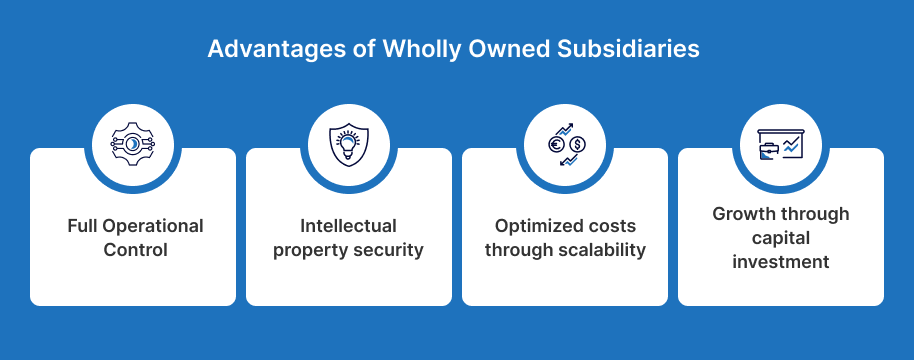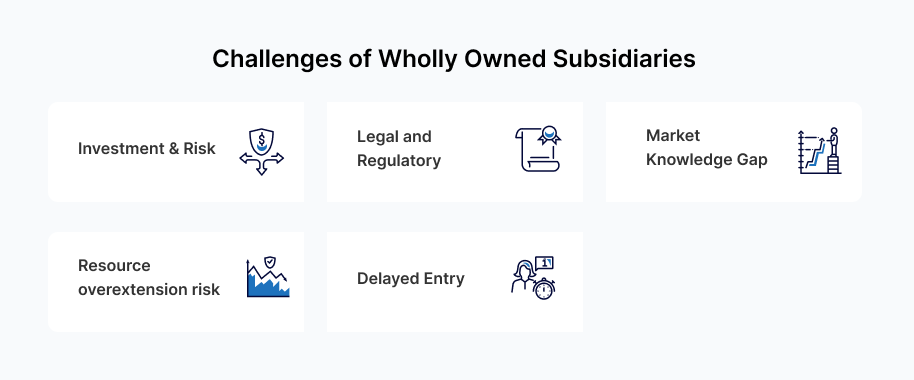Expanding into new markets is a critical strategy for multinational corporations seeking growth, diversification, and competitive advantage.
Establishing a wholly owned subsidiary is one approach that enables complete control and operational independence.
While this model offers strategic benefits such as full autonomy, intellectual property protection, and brand consistency, it also presents challenges, including high capital investment, regulatory complexities, and cultural adaptation.
This article examines the advantages and challenges of wholly owned subsidiaries, providing a comprehensive analysis for business owners, investors, and corporate decision-makers considering this expansion strategy.
What Are Wholly Owned Subsidiaries?
A wholly owned subsidiary is a separate legal entity whose entire stock is owned by a parent company. This structure allows the parent company to maintain complete ownership and control over the subsidiary’s operations, strategic direction, and financial management.
Despite being an independent entity in legal terms, a wholly owned subsidiary functions under the direct influence of the parent company.
This ownership model is particularly common among multinational corporations entering foreign markets or expanding into new industry segments, as it provides a controlled and secure platform for business growth.
Advantages of Wholly Owned Subsidiaries
One of the primary benefits of a wholly owned subsidiary is the ability to maintain complete control, allowing for maximum flexibility in decision-making. To have a better understanding of it, let’s explore the benefits of wholly owned subsidiaries

- Full Operational Control: Wholly owned subsidiaries enable parent companies to exercise complete control over business operations, financial management, and strategic planning. This level of authority allows for:
- Swift and Independent Decision-Making: Unlike joint ventures or partnerships, where consensus among multiple stakeholders is necessary, wholly owned subsidiaries allow the parent company to implement decisions without external approval.
- Strategic Alignment: The subsidiary’s operations can be seamlessly integrated into the parent company’s broader corporate strategy, ensuring consistency in business objectives and operational goals.
- Flexible Resource Allocation: The parent company can prioritize investments and distribute resources based on strategic needs rather than negotiating with external partners.
- Intellectual property security: Multinational corporations often possess proprietary technologies, patents, and trade secrets that provide a competitive edge. A wholly owned subsidiary ensures:
- Exclusive Control Over Intellectual Property (IP): The parent company retains ownership and can implement stringent security measures to prevent unauthorized use, replication, or theft.
- Risk Mitigation in Foreign Markets: In jurisdictions with weaker IP laws, operating through a wholly owned subsidiary provides better safeguards compared to licensing agreements or joint ventures, where IP exposure is higher.
- Brand Consistency and Reputation Management: Establishing a wholly owned subsidiary allows businesses to maintain uniformity in brand messaging, product quality, and customer experience across different markets. This structure ensures:
- Centralized Brand Governance: The parent company can enforce global branding standards, ensuring consistency in marketing, product positioning, and corporate identity.
- Control Over Customer Experience: Wholly owed subsidiaries, unlike franchise models or joint ventures, ensure consistent brand representation, service delivery, and customer interactions through direct control.
- Greater Financial and Operational Efficiency: By leveraging its financial strength, the parent company can optimize the subsidiary’s performance through:
- Optimized Costs Through Scalability: The parent company can negotiate better terms with suppliers, optimize supply chains, and consolidate operations to reduce overall costs.
- Capital Investment for Growth: By maintaining full ownership, the parent company ensures strategic funds deployment, empowering growth free from any restrictions.
Challenges of Wholly Owned Subsidiaries
Although wholly owned subsidiaries provide substantial benefits, companies must thoroughly assess the potential challenges before choosing the expansion model.

- Investment & Risk: The establishment of a wholly owned subsidiary requires a substantial capital commitment, including expenses related to:
- Legal Incorporation and Compliance: Registering a new entity involves legal fees, government approvals, and regulatory compliance costs, which vary by jurisdiction.
- Operational Infrastructure: Setting up offices, manufacturing facilities, or distribution networks demands significant investment, particularly in foreign markets with high real estate and labor costs.
- Ongoing Financial Responsibility: Unlike partnerships where financial risks are shared, the parent company bears full responsibility for funding the subsidiary’s operations, even in the face of economic downturns or market fluctuations.
- Complex Legal and Regulatory Compliance: Each country has distinct regulatory frameworks governing foreign businesses. A wholly owned subsidiary must navigate:
- Local Business Laws: Compliance with corporate governance, labor laws, and industry-specific regulations is essential to avoid legal disputes or operational disruptions.
- Taxation Complexities: Cross-border taxation, transfer pricing, and foreign exchange regulations require specialized financial planning to optimize tax efficiency while ensuring legal compliance.
- Licensing and Operational Approvals: In some jurisdictions, obtaining the necessary permits and licenses can be a lengthy and bureaucratic process, delaying market entry.
- Market Knowledge Gap: While wholly owned subsidiaries provide operational independence, they may face difficulties in adapting to local business environments due to:
- Talent Acquisition and Retention: Recruiting skilled professionals can be challenging, particularly in competitive labor markets where global corporations must compete with local firms for top talent.
- Cultural and Market Insights: The parent company may lack an in-depth understanding of consumer behavior, market trends, and business etiquette, potentially leading to ineffective marketing strategies and operational inefficiencies.
- Resource Overextension Risk: Expanding through wholly owned subsidiaries requires careful financial planning, as overextension can:
- Limit Business Diversification: Relying too heavily on wholly owned subsidiaries may concentrate risk in specific regions or industries, reducing the company’s ability to adapt to changing market conditions.
- Increased Financial Exposure: If the subsidiary underperforms, the parent company absorbs all financial losses, potentially impacting overall profitability and shareholder confidence.
- Delayed Entry: Compared to joint ventures or strategic partnerships, wholly owned subsidiaries often face longer setup and market penetration periods due to:
- Lengthy Legal and Administrative Processes: Establishing a new entity requires registration, permits, and compliance approvals, all of which can delay market entry.
- Gradual Relationship Building: Unlike joint ventures that benefit from local partners’ established networks, wholly owned subsidiaries must build trust with suppliers, customers, and regulatory authorities from the ground up.
Conclusion
A wholly owned subsidiary is an effective expansion model for companies seeking complete control, strong brand positioning, and intellectual property security.
However, the significant capital investment, regulatory complexities, and market adaptation challenges require thorough planning and risk assessment.
Businesses considering this model should conduct detailed market research, evaluate financial feasibility, and develop a long-term strategic roadmap to ensure successful international expansion.

